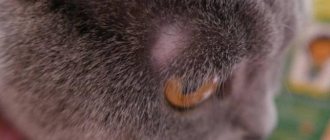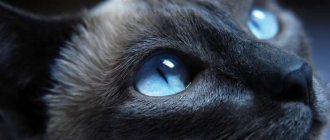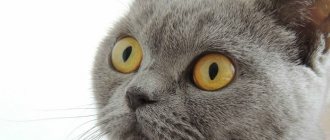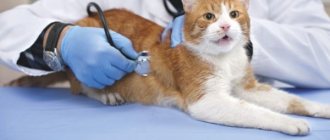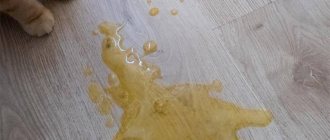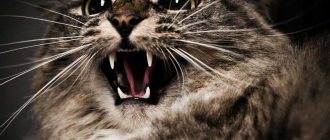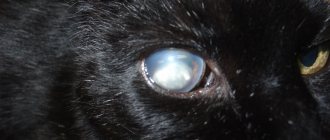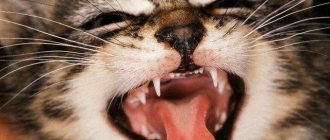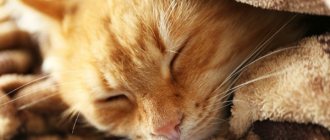For what reasons does the disease appear?
The detection of a white film on the eyes of cats or the third eyelid, the formation of purulent discharge, swelling: indicates that the fluffy cat has obvious problems with the visual apparatus. Such violations can be detected for all sorts of reasons:
- for various conjunctivitis;
- due to mechanical impact;
- with entropion of the eyelids (entropion) – Maine Coons, British, Persians and Scottish Folds are at risk;
- if you are allergic to various irritants;
- with corneal necrosis;
- as a result of chemical exposure to the mucous membrane of the visual organ;
- if the fluffy has microparasites (internal or external);
- if there are problems in the functioning of the gastrointestinal tract and other organs;
- if the mustache is bothered by internal diseases (bacterial, viral or fungal);
- due to the formation of tumors (adenomas).
You should know that the cat's third eyelid is a necessary part of the visual apparatus in whiskers, which performs a protective function: to prevent infection from entering the mucous membrane of the eye and as a kind of barrier that softens the effects of mechanical damage.
This whitish or bluish eye membrane is practically invisible when looking at the barbel. You can notice it when the purr bends its head towards the floor or begins to blink, then a thin film completely covers the entire eye.
This action helps the mustache get rid of excess dust particles, and also promotes the distribution of tear fluid inside the eyelid.
If the third eyelid falls out or a film becomes visible on one or both eyes in cats, then it is necessary to determine the root of the problem and begin treatment immediately.
What symptoms indicate illness?
Any pathological process in an animal’s body is accompanied by specific signs. It is recommended to pay attention to any changes in the behavior and appearance of the pet. Problems with cat vision are accompanied by the following symptoms:
- the animal has an increased secretion of tear fluid;
- the cat hides in dark places and does not tolerate bright light;
- the appearance of a purulent film and unpleasant discharge is noted;
- the cornea becomes cloudy and acquires a reddish tint;
- the pupil changes shape;
- often the cornea acquires an uneven color, the surface becomes loose;
- with some pathologies, the thorn becomes convex;
- blurred vision, strabismus;
- in advanced cases, complete atrophy of the visual organs occurs.
Your cat has worms: how to treat them at home
Cloudiness of the cornea of the eye
It is recommended to pay attention to your pet's behavior. The animal bumps into walls and has visual problems. The cat becomes irritable, does not want to communicate, often washes itself, trying to remove what interferes with normal vision. If your pet is inflamed, it is difficult to wash it; it causes pain.
Important! It is necessary to promptly notice any changes in the cat’s visual organs. Advanced disease is more difficult to treat.
Diagnosis of why a cat's eye is half closed
If the above signs occur, you should immediately sound the alarm and do not delay a visit to the veterinarian.
The disease can pose a real threat to the health of your pet, making it blind.
I will talk about different types of third eyelid prolapse:
- Protrusion. When the film covers more than half of a cat's eyelid, the color of the film is white or grayish. Most often, protrusion is just a symptom of deeper diseases of the nervous system.
- Prolapse of the nictitating membrane. It is diagnosed if the film covers no more than half of the organ. It is a pink spherical formation in the inner corner. It occurs quite rarely only in cat breeds with a flattened muzzle. May be accompanied by purulent conjunctivitis. If pus is present, emergency surgery is required.
- Eversion. A rare pathology is a crease in the cartilage of the third eyelid. Very similar to prolapse, but with curvature of the cartilage in the inner corner of the eye.
- Third century injury. Occurs when damaged by claws during fights or mating games of cats. The damage is accompanied by blood and purulent conjunctivitis. If the gap is small, you don’t have to worry, because the wound will heal on its own if the pet is in good health. I advise you to contact a veterinarian if the affected third eyelid can separate and hang on your pet’s eye. No need to hesitate! After all, the sooner you and your veterinarian solve the problem, the greater the chance of restoring the full functioning and mobility of the third eyelid.
- Horner's syndrome. This is a serious neurological disorder with a white film on the eye, drooping of the eyelid and constriction of the pupil. Cats with this syndrome are diagnosed with dysfunction of the brain, neck, and nerve plexuses. If you find such symptoms in your pet, consult a neurologist.
A cat's dehydration, exhaustion, prolonged vomiting, diarrhea and general depression can cause third eyelid prolapse in both eyes.
If, apart from the white film, you do not observe other symptoms, this may be Haw's syndrome.
Third eyelid injury
In this case, there is no need to see a doctor - your pet’s eyes will eventually regain their previous appearance.
The examination of the animal is carried out in a certain order, which allows you not to miss details or nuances when differentiating the diagnosis:
- assessment of vision of the damaged organ (preserved or not);
- assessment of general appearance and comparison of symmetrical features (size and shape of pupils, size of the palpebral fissure, size and changes in the eyelids, size of the eyeballs);
- assessment of the condition of the eyeball (size, shape, presence of injuries, location in the pupil).
We suggest you read: Amyloidosis in cats: signs, diagnosis and treatment
If, apart from the white film, you do not observe other symptoms, this may be Haw's syndrome.
The cause of the underlying pathology is determined. Pay attention to the symmetry of the eye lesion. If clinical symptoms are observed on one side, then the cause of the disease is a congenital anatomical anomaly that requires surgical correction. Or is it the irritating effect of a foreign object caught under the film.
It is necessary to monitor the dynamics of the disease. A conscientious fellinologist records everything that happens to the cat in writing. Your veterinarian may need this information when taking your medical history. For example, with chlamydia, sometimes one eye is damaged, then the other.
Why does a cat have a film on its eyes?
The main reason for the appearance of a film on the eyes is suppuration, the appearance of formations in the eyes and tearing. If the eyelids are swollen and the film is bluish in color, then the cause of the problem is inflammation of the eyes. Here it is better to take the animal to a veterinary hospital, where, using an ophthalmoscope, the doctor will examine the eyes, determine the cause of the disease and offer high-quality effective treatment. If the cause of such a film on the eyes is strabismus, blocked ducts or cataracts, then the help of a surgeon is required. But if the main reason for the film is only the third eyelid, then this is a fairly common phenomenon.
External manifestations of the disease
The presence of a third eyelid in a mustache is signaled not only by a change in the cat’s appearance, but also by changes in its behavior:
At the same time, you can see profuse lacrimation in your pet, possibly the presence of pus and a change in the shade of the mucous membrane to red. If you do not help the tailed creature, there is a high probability of vision loss.
Loss of the third eyelid in a pet is not always a dangerous sign; in old cats this phenomenon is common, which is explained by age-related changes (weight loss, sunken eyes). In any case, the best solution would be to consult a specialist.
Treatment
Therapy is prescribed depending on the diagnosis. Surgical and conservative treatment methods are used.
A small tumor is removed surgically without affecting the membrane itself. A large tumor is excised along with the film, and the animal is at risk of blindness.
Injuries are treated conservatively if they are shallow. Such wounds in cats heal quickly.
The injured nictitating membrane is sutured, then antibiotics are prescribed.
For inflammation due to bacterial infection, broad-spectrum antibiotics are prescribed in the form of drops and ointments.
For fungal diseases, fungicidal ointments are used.
Vitamins, minerals, nutrients, and immunomodulators are prescribed as additional treatment.
White film on both eyes is a dangerous sign
If you find a whitish film on one eyelid of a furry cat, then most likely this change occurred due to the entry of a speck or other foreign body. A more dangerous situation is when a film is detected on both eyes of the cat, which is most likely caused by an infectious disease.
Very often, males damage their eyes with their claws during a fight. Wounds that appear on the eyelids can easily become infected.
If there is an infection, a film may form in the eyes of the mustache. Some diseases (keratitis, corneal ulcer, etc.) signal themselves by the appearance of green or white discharge. If such signs are noticed in your pet, then urgently take him to the veterinary clinic.
Causes
Veterinarians divide the causes of eyesores into two main groups: congenital and those that appear during life.
Congenital lesions account for only 7-10% of cases. This can happen if the organ of vision is not formed correctly or due to the fact that the cat was very sick during pregnancy. In this case, most often the problem affects several or even all kittens in the litter.
The following factors can lead to an acquired thorn:
- infections and viruses that affect the cat’s body;
- parasitic diseases localized to the cornea;
- mechanical damage and injury to the eye or nearby areas;
- metabolic disorders leading to excessive accumulation of cholesterol and calcium;
- prolonged action of the allergen;
- impaired renal function, leading to severe swelling of the mucous tissues and conjunctiva;
- destructive processes caused by aging.
About 90% of cases are of the acquired form, which is most often reversible. Even after serious injuries, when it seems to the owners that their vision cannot be saved due to a huge spot on the cornea, veterinary care in most cases can fully or partially restore the animal’s ability to see the world around normally.
About first aid measures
So what to do with the cat? Let us immediately note that you should not do anything on your own without first consulting with a veterinarian. This way you can only seriously harm your pet’s health, and in some cases leave him without an eye altogether.
But in mild cases of conjunctivitis, the owner can help the cat. To do this, you can use a weak solution of hydrogen peroxide. A cotton swab is moistened with it and the crusts and liquid exudate that accumulate in the corners of the eye are carefully washed off. At the same time, tetracycline ointment is placed under the eyelid (pictured). It effectively relieves inflammation and reliably prevents the further development of pathogenic microflora.
To wash the eye itself, it is better to use a weak solution of either furatsilin or potassium permanganate. In the latter case, the color of the medicinal composition should be pale pink, since in higher concentrations potassium permanganate can be dangerous for the cornea. In addition, good results are obtained by washing the eyes with decoctions of sage and chamomile. They have a bactericidal effect and also relieve swelling and the main signs of the inflammatory process.
Why does prolapse develop?
When a cat's eyes are half covered with a film, they speak of prolapse of the third eyelid. In this case, the cat feels discomfort and his vision gradually deteriorates, up to its complete loss. The reason for the development of this degree of disease may be associated with pathology of the organ of vision itself, as well as with diseases of the nervous system or gastrointestinal tract, reduced immunity of the pet, or with a fracture of the nictitating membrane as the kitten grows older.
Some cat breeds even have a genetic predisposition to third eyelid prolapse, which often occurs within the first year of life. And due to the hypertrophy of the nictitating film, it constantly rubs against the cornea, irritating the mucous membrane of the latter. At the same time, kittens with such an injury begin to rub their faces, wanting to get rid of the unpleasant sensation.
The film on the eyes of cats is often associated with inflammation, when the membrane becomes swollen, its hyperemia and prolapse develop. All this causes discomfort to the pet, and he washes himself more often.
Prolapse also develops during burns with aggressive chemicals or thermal burns, which injure not only the conjunctiva, but also the cornea of the eye. The affected tissues are swollen, reddened, lacrimation is observed and the cat feels a burning sensation and severe pain in the eyes. He begins to behave restlessly, shaking his head and rubbing his muzzle. The most dangerous burns are those of chemical origin, since they often injure deep-lying tissues and are complicated by bacterial infection.
The peculiarity of burns is that the severity of the injury can be assessed only on the second or third day from the moment it was received . Most often only one eye is affected.
If a kitten's cartilage tissue develops incorrectly, a fracture of the nictitating membrane may occur that cannot be restored. In this case, the third eyelid loses its functional abilities.
© shutterstock
Prolapse of the third eyelid is also possible with rhinotracheitis, when the disease is in its initial stage or in a mild form. In this case, the kitten experiences rhinitis and a rise in body temperature, it becomes apathetic, eats poorly or refuses to eat at all.
Sometimes the cause of the pathology is a membrane adenoma, which looks like a pink or red growth in the corner of the eye, which gradually grows, covering the eye . In this case, the cat experiences lacrimation, a rise in temperature, a worsening general condition, it becomes aggressive and cannot completely close the affected eye.
How to help your pet?
When an illness is identified, it is better to immediately identify its cause by seeking the help of an experienced veterinarian.
First, the veterinarian will examine the affected area using an ophthalmoscope and take smears from tear secretions, which will help exclude or confirm the presence of an infectious disease.
If the root of the problem is a disease, the specialist will prescribe anesthetic drops for sore eyes and special ointments. Of course, it is very important to stop the disease itself.
At the same time, the cat's eyes will need to be washed at home to rid them of dirt. If you notice that a kitten or an adult suffers from lacrimation, suppuration and constantly rubs its eyes, then use the following ingredients as a wash:
- boric acid;
- olive oil;
- warm clean water.
Secure the pet well; it is better to carry out the procedure in pairs, wrapping the mustache in a towel. Then gently rinse her eyes using a generously moistened cotton pad or pipette. Afterwards, wipe your pet’s eyes with a clean swab from the outer corner of the eye to the inner.
For suppuration and tearfulness, Lacrimin drops are effective. If creatitis is detected in a tailed creature, then you cannot do without medical help - follow all the doctor’s instructions, this will preserve your pet’s vision.
For cataracts (when, in addition to the formation of a film, the lens becomes cloudy), blockage of the ocular ducts and strabismus, surgical intervention will most likely be required.
It is undesirable for the cat to rub its eyes during therapy, so it is better to use a special veterinary collar.
First aid
Self-medication in this case is strictly prohibited. Medicines are used only after consultation with a veterinarian. If you delay in going to the clinic, your pet’s condition will quickly deteriorate.
As soon as the owner notices that his pet has a white film on the organ of vision, and an urgent visit to the veterinarian is impossible, the animal is treated at home.
Wiping the eyelids
Take a clean cotton cloth, moisten it with warm filtered water, and carefully remove all discharge from the eyes from the outer corner to the inner one.
Moisturizing the eyes
If the eye is swollen, carefully spread the eyelids and drip saline solution. If the film falls out, periodically moisten the eye with saline solution and apply a sterile bandage.
Help with bleeding
If bleeding occurs, apply a sterile bandage or gauze folded in several layers to the eye (the material should not stick). When soiled, the bandage is changed, but at least once a day.
Examination by a veterinarian
At the clinic, the doctor conducts a full examination of the pet. An ophthalmoscope is used to examine the condition of the fundus.
If there are no injuries, clinical tests are prescribed.
Causes and symptoms of eye diseases in cats
The most common diseases in cats are:
Inflammation of the eyelids
. With phlegmous inflammation, the eyelid swells and purulent mucus flows from the eye. With normal inflammation, the cat begins to scratch its eyes. The eyelids become red and thickened. The disease appears due to vitamin deficiency, eczema. Phlegmous inflammation develops after strong calculations and deep wounds.
Bruises and wounds
. A cat can receive these injuries from a fall or after a fight. The wound can be superficial, deep or through. The main symptom is severe swelling, redness and even bleeding from the eyes.
Turn of the century
. The skin turns inward. This causes a strong inflammatory process. Volvulus can be caused by a foreign body getting into the cat's eye or exposure to chemicals. Without timely assistance, the cat may develop conjunctivitis or keratitis. In advanced cases, an ulcer will appear on the cornea.
Symptoms of the disease include lacrimation and photophobia. The eyelid begins to swell, changing its appearance.
You can recognize the listed eye diseases in cats from photos.
Types of conjunctivitis
Conjunctivitis is considered the most common disease among cats. It has the following varieties:
- Purulent.
- Allergic.
- Acute catarrhal.
- Follicular.
With purulent conjunctivitis, the general condition of the cat worsens. The animal's body temperature rises, and copious pus begins to discharge from the eyes. Diarrhea and vomiting may occur.
Allergic conjunctivitis
in a cat it causes contact with an allergen. At first, the discharge from the eyes appears clear. If left untreated, they become purulent.
Acute catarrhal conjunctivitis is always accompanied by redness of the eyes and severe swelling. Cats experience pain, tears flow, and serous-mucous discharge occurs. The main reason is injury and lack of vitamin A in the body.
Follicular conjunctivitis is characterized by inflammation of the lymphatic follicles. They are on the inside. The disease is chronic and requires long-term treatment. Surgery is possible.
Why does protrusion develop?
A protrusion can appear when a foreign body enters the eye or it is injured, for example, during a fight between cats. In this case, the disease is more often present in one eye, and the owner observes how the pet’s eye gradually becomes covered with a white film. At the same time, the pet develops a feeling of pain in the eye, pain and burning, which is why it rubs its muzzle with its paws to get rid of the irritant. If treatment is not started, there is a high probability of bacterial infection. In this case, purulent discharge appears from the eye, and the conjunctiva becomes red.
Often, the formation of a protrusion is observed with conjunctivitis, when clear clinical signs in the form of purulent discharge have not yet appeared. In this case, the conjunctiva of the cat’s eye becomes bright red and tearing is observed, and the corners of the eyes are covered with a film. At the same time, he has pain and itching in his eyes, the animal rubs his muzzle more often and behaves restlessly. The infection usually affects one eye, but when the cat washes itself, it transfers the disease from the affected eye to the healthy eye.
When a film appears on a cat’s eyes, the owner may think about the pathology of the nervous system. In this case, the protrusion is accompanied by a constricted pupil on the affected organ of vision, and a slightly pronounced drooping of the upper eyelid. This problem requires an urgent visit to the veterinarian, since it may be a manifestation of a serious pathology.
© shutterstock
If a cat has a film in the corners of his eyes, it is worth thinking about possible protrusion due to helminthic infestation. This symptom occurs not only in cases where the parasites are located directly in the eye, but also when they are in the intestines. In this case, the pet’s condition is disturbed, it quickly loses weight, does not eat well, diarrhea or vomiting begins, the body temperature rises and after a while the hair begins to deteriorate and fall out.
Preventive measures
To protect the tailed creature and minimize the occurrence of problems with the visual apparatus, you should do the following:
- plan a cat’s diet - it must be balanced and consist of quality products;
- do not forget about additional vitamins in the cat’s menu;
- periodically rinse your cat's eyes with Furacilin (1 tablet per 100 g of water);
- use potassium permanganate for preventive purposes;
- regularly examine the eyes of the mustachioed creature and monitor changes in its behavior;
- do not forget to free your pet from roommates - worms, fleas, etc.
- Take your pet to the veterinary clinic for examinations at least once a year.
If you notice slight redness of the mucous membrane and tearing, use Tricilin powder on the affected areas.
Therapy
Treating a cat's eyesore requires a comprehensive approach. Of great importance in determining the course of therapy is the diagnosis (statement of the underlying disease that caused leukoma). The stage of the disease and the previous clinical picture matter.
Timely diagnosis and first aid for the cat determine further tactics. In the vast majority of cases, this is conservative therapy with the use of medications.
Severe cases, accompanied by serious symptoms and complications, require surgical intervention. During the operation, the surgeon carefully removes the resulting film, replacing the affected area of the cornea with artificial tissue.
Treatment of an eyesore in a pet with medications includes:
- thorough cleansing of the affected areas of the cornea with special disinfectants;
- use of antibacterial ointment in the lower eyelid area;
- administration of painkillers in the form of drops;
- instillation of drops, widely used in the field of ophthalmology to eliminate symptoms;
- washing the affected eye with antiseptic agents that relieve inflammation and discomfort.
Leukoma can be cured only through complex treatment using evidence-based medicine and traditional methods. It is important to note that infusions and decoctions of medicinal plants to clean the affected eye of a cat can only be used after consultation with the treating veterinarian and in combination with medications. You can use resin from fir trees, celandine mixed with propolis, a decoction of chamomile and calendula.
Prevention
If the film has already appeared, I advise you to adhere to the following rules when caring for your pet at home:
- Good balanced diet;
- If you discovered the film on the first day, I advise you to use Lacrimin or Tricilin powder;
- Add vitamins to food;
- Dissolve a furatsilin tablet in 100 grams of water and rinse the sore eye;
- Make lotions with a solution of manganese;
- Instill antibiotics, for example cyprobid or colbiocin;
- Apply Zovirax ointment to the film.
To protect your pet, you need to constantly carry out various preventive measures. After all of the above, I want to summarize - periodic prevention, timely diagnosis and treatment of the disease will help your pet stay healthy and preserve his vision. Be careful about those you have tamed!
Methods and methods of treatment
To treat eye diseases, veterinarians use many different techniques, from anesthetic eye drops to the use of special ointments and others. The simplest and most effective remedy is preventive rinsing of a cat’s eyes; this is a useful and very good procedure that makes it possible to remove pollen and various particles from the eyes. This action is rather a general prevention that can remove the cause of more serious diseases. This rinsing needs to be done periodically when the cat’s eyes become watery, suppuration appears, or a film forms on the eyes. For washing use:
- boric acid;
- olive oil;
- warm water.
It is better to do this procedure together, so that the assistant holds the cat well, this will be more practical and convenient.
If a cat’s eyes are watery, then this is a fairly common problem, and if the eyes have already become purulent and filmy, then the animal needs to be treated quickly.
To treat watery eyes, as well as if a film has just appeared, it is better to buy drops such as Lacrimin.
If a cat has creatitis, then it is better to use more serious medications and urgent treatment measures, otherwise there may even be loss of vision. Not every cat will allow her eyes to be examined and treated, so it is better to call an experienced veterinarian who will give her an injection for treatment.
Useful materials:
- Cutaneous horn General description of the disease Cutaneous horn on the forehead or face (ICD 10 code - L57.0) -...
- Itching and odorless discharge Main causesBefore considering the factors that provoke the appearance of discharge that has a sour odor, it is necessary to immediately note...
- Normal temperature in animals Normal temperature in different types of animals Veterinary services Day hospital for animals Veterinary certificates Vaccination…
- Discharge in women What kind of discharge between menstruation is considered normal? Female discharge normally consists of mucus from the cervical canal, dead...
Third eyelid in a cat: reasons
First of all, the film is formed due to suppuration and tearing of the eyes. You can talk about inflammation if the film is blue and the eyelids are slightly swollen. In this case, the owner of the animal must bring it to the veterinary clinic. The doctor, using an ophthalmoscope, examines the eyes, determines the cause of the disease and prescribes the necessary medications. Surgery is necessary if the cat has cataracts, strabismus, or blocked ducts. A cat's third eyelid is not a cause for concern if it does not bother the animal. However, it is better to show your pet to a veterinarian in a specialized clinic.
How to treat and what to do
If the disease is diagnosed in time, the problem can be easily eliminated. To do this, doctors resort to anesthetic drops, special ointments and, in severe cases, surgery.
To prevent loss, I recommend not to forget about proper care of your pet’s eyes, rinse them more often with boric acid, olive oil or just warm boiled water.
This procedure will help protect against infections in the future and remove foreign particles from the eyelids.
Based on practice, I recommend involving another person in this process, since it is difficult for one person to hold the animal and drip eyes.
Drops with an anesthetic effect help relieve inflammation
Diagnosis and treatment
Only a veterinarian can make an accurate diagnosis. It consists of a comprehensive examination, including:
- inspection;
- collection of tests;
- blood test (biochemistry, general);
- analysis of the mucous membrane of the eye;
- PCR diagnostics and ultrasound examination of the eye.
After all the tests and determination of the cause, the doctor prescribes appropriate treatment. Possible purpose:
- Drugs against fungi and viruses - suppress the development of harmful organisms in the eye.
- Antipyretic and painkillers - to make the cat more comfortable to endure the disease.
- Immunostimulants, vitamin and mineral preparations - to strengthen the immune system. They can give vitamin injections (Gamavit).
- Hormonal and antihistamines (in advanced cases).
Washing is prescribed for injuries and debris.
Advanced diseases may require surgery. It is rarely resorted to, as it entails some unpleasant consequences: dry eye syndrome, complications, etc. Veterinarians prefer therapy.
If you have the slightest suspicion of eyelid loss, contact your veterinarian - the disease is easier to prevent than to treat
Treatment largely depends on the underlying cause. Therefore, it is worth considering each case separately.
Parasite infestation
Naturally, in such cases, the first point is getting rid of the parasites themselves. Fleas are eliminated by double treatment with drops or spray, repeating the procedures every 2–2.5 months. For prevention, an anti-flea collar is put on the cat. For worms, take an anthelmintic drug 2 times every 11 days and then every 3 months.
If the case is not advanced, the veterinarian will prescribe washing at home with special cleansing drops (for example, Beaphar Oftal), as well as vitamin complexes to strengthen the immune system. In advanced cases, immune drugs, anti-inflammatory drops or gels are prescribed.
Fleas can cause third eyelid prolapse
Allergic conjunctivitis
Such a disease will manifest itself not only through eyelid loss. Allergies are often accompanied by dry skin, itching, redness, rash, and in severe cases, swelling of the larynx. It is necessary to show the cat to a doctor at the first suspicion of an allergy, then you will be able to avoid eyelid loss.
If, however, the third eyelid has fallen out due to allergies, the first step is to identify the allergen. This is quite difficult and is done by a veterinarian. When the allergen is eliminated, antihistamines are prescribed, for example, Kestin, Zyrtek, Fenistil, etc. If the case is advanced, hormonal drugs may be prescribed: Dexamethasone, Prednisolone.
Watery eyes are one of the signs of eye problems.
Viruses, fungi, bacteria
Infections are especially dangerous for a cat's eyes and can result in complete blindness. First of all, the veterinarian carries out a diagnosis: the infection can be detected by taking an analysis from the cornea of the eye. If it shows infection, then comprehensive treatment is prescribed. As a rule, these are antibiotics, antifungal and antiviral drugs. There can be both general (injections) and local (drops, gels) actions.
Very often, for infections, symptomatic treatment takes place: antipyretics, prevention of dehydration and vitamin deficiency (injections, including Gamavit), painkillers and immunity-strengthening medications. The cat needs complete rest and high-calorie food.
Viruses are especially dangerous for cats' eyes
Adenoma
This benign formation on the third eyelid looks like a small bright pink tumor, which is dangerous because it can infect or injure the eye, and also causes significant discomfort to the cat. It can only be removed surgically, in advanced cases - along with the third eyelid.
After the operation, antibiotics and anti-inflammatory drops (Bars, Diamond Eyes, Iris, etc.) are prescribed. A collar is put on the cat to prevent it from scratching its eyes.
If your cat has had her third eyelid removed, take care of the safety of her eyes: after completion of treatment, use special caring eye drops (Cliny, Phytoelite VEDA, etc.) daily.
Adenoma of the third eyelid is a benign tumor
Contact with a foreign body in the eye
Foreign bodies in the eye are not that uncommon. They can be removed at home by thoroughly washing the eye with a well-moistened piece of natural fabric (not cotton wool - it will leave microparticles in the eye that can inflame it more). This must be done carefully so as not to damage the eyes. If the body cannot be removed, then contact your veterinarian - he will remove it with special tweezers or perform a rinse.
After this, special drops (Sofradex) are instilled into the eye. Then apply ointment to the eye: hydrocortisone or Oogzalf. If the eye was severely injured or the situation was advanced, proceed as in the case of an eye injury.
If a foreign body enters the cat, it may scratch its eye, so keep a close eye on it.
Eye injury
If you suspect an eye injury (severe redness, the animal cannot see normally, blinks quickly, scratches the eye), then carefully rinse the eye with a weak solution of furatsilin. Then take your cat to the vet immediately.
As a rule, treatment is based on antibiotics (Bars, Normax, Tsipromed, etc.). Be sure to use a collar to prevent the cat from injuring itself further. In case of severe and advanced injuries, anti-infective and anti-inflammatory, painkillers and antipyretics are prescribed.
If your cat's eyes are red, this may be a sign of injury.
Internal diseases
The first point is the diagnosis of internal diseases using ultrasound, x-rays, and tests. The cat is prescribed treatment depending on the disease. For the eye, complex therapy is used in the form of special drops or ointments. Often a special diet with medicated food is prescribed.
